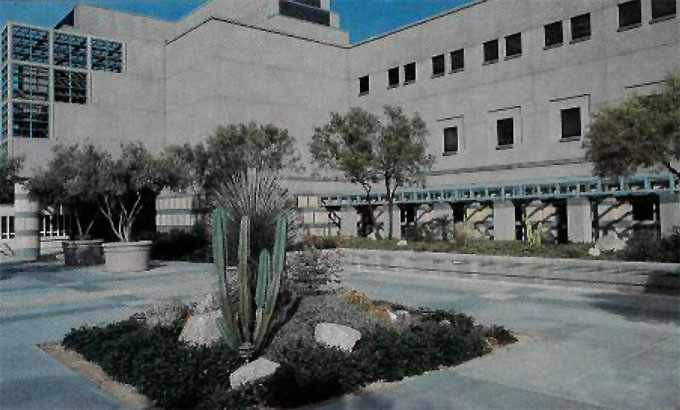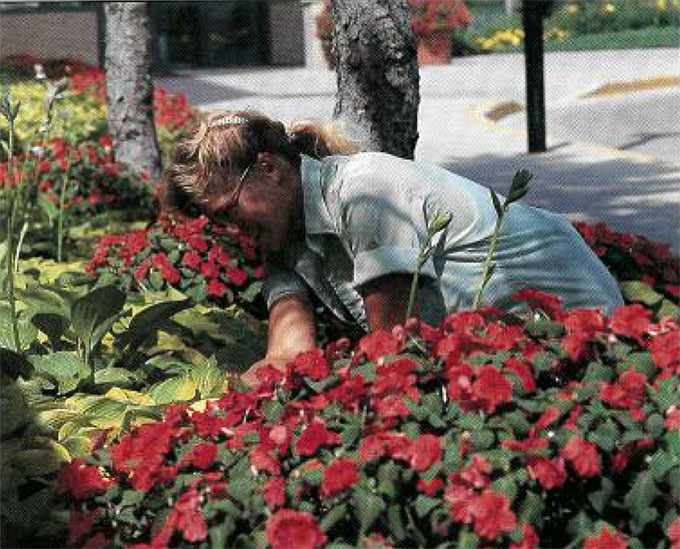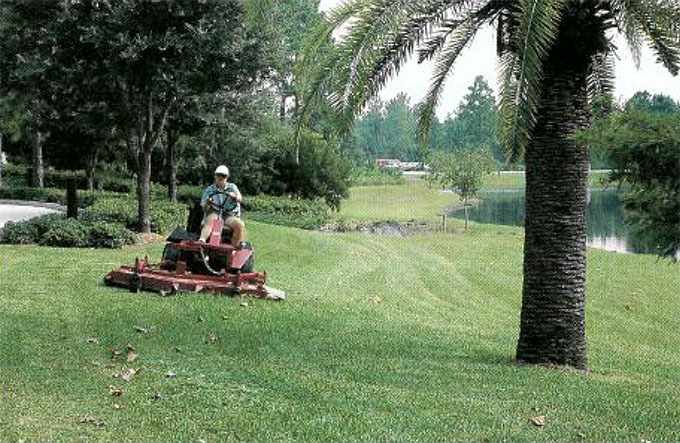-
#FlashbackFriday 1991: Landscaping Across Three Climates

This article first appeared in September 1991, in the publication Mayovox.
Mayo’s three geographic locations could scarcely be more different from one another. Consider: the interplay of light and landscape in the Sonoran Desert, the seasonal extremes in the rolling hills of southern Minnesota, and the semi-tropical wetlands of Florida. Add to that the variety of plant and animal life on Mayo’s grounds in any of the three regions. Now you’re beginning to understand the challenges faced by groundskeepers at Mayo — an organization committed to protecting, conserving, and reusing natural resources.
Thriving desert in Scottsdale
Patients and visitors at Mayo Scottsdale often comment that the grounds look as though nothing in the desert was moved or disturbed when the clinic building, parking lots, driveways and walkways were built. Those who know something about successful revegetation and landscape design know that it took careful planning and placement of transplanted plants, trees and bushes to achieve this undisturbed effect.
Mayo’s efforts were noticed in 1989 when Mayo Clinic Scottsdale won third place in the commercial division of the Desert Botanical Gardens’ Arid-Zona Awards for Excellence in Landscape Design. The award is given to those who have demonstrated that landscape designs can be beautiful while they conserve water and reflect the unique desert environment. The photograph above illustrates the desert plants and water conservation that shape the regional tone of the grounds.
When preparing to build, desert terrain was carefully removed from the site of the future clinic (including anything within 200 feet of the building site). The terrain was stored for later replanting. Another 10 feet of terrain on each side of the main driveway was also removed and safely stored during construction.
When the clinic building was completed, the stored cacti, native trees and shrubs were transplanted back into the desert surroundings. Hydroseeding and hand seeding of native shrubs, grasses and wild-flowers helped to re-establish the grasses and keep them in place until the rain came.
“The entire transplanting process was in keeping with the City of Scottsdale Foothills ordinance,” says Bill Barnes, grounds technician for Mayo Clinic Scottsdale. Findings in the zoning ordinance amendment show that native vegetation within the city of Scottsdale is a unique natural resource that promotes tourism, contributes to high property values, stabilizes desert soils, provides food and protection for desert wildlife, and contributes to the economic and aesthetic well-being of the community.
Volunteer tour guides (docents) introduce visitors to the desert surroundings during “Desert Walks and Talks,” a series of slide-show presentations and desert tours at the clinic’s own nature trail.
“It is truly a gift to the city that the desert area has been kept intact and set aside for Mayo patients and friends to enjoy,” says Sudelle Irons, chair of Mayo Clinic Scottsdale’s Desert Docent program. “While walking on the natural trail, many visitors find the Sonoran Desert lush and alive, and are fascinated to learn how the animals and plants have adapted and survive quite well in the desert environment.”
Rochester, a small-scale Windy City
A blustery day in downtown Rochester sends residents and visitors hurrying for shelter. Winter winds can spell dehydration for trees. But for a falcon preparing to take to the sky, strong wind creates the updrafts necessary to soar high in search of prey. At Mayo Medical Center in Rochester, some environmental factors impact groundskeeping in subtle ways. The photograph below shows Teresa Heckman, summer groundskeeper, tending shade-loving hosta and impatiens on the north side of the Eisenberg Building.

Other environmental factors, such as climatic extremes in southern Minnesota, impact the Rochester campus in not-so-subtle ways. The cold climate necessitates use of winter-hardy plants. Even so, year-round preparations are necessary to help plants survive the cold winter months.
Grounds crews begin their preparation with ample watering throughout the warmer months, especially before the fall freeze. This helps plants endure dehydrating winter winds. They also wrap the trunks of young trees in the fall to protect them from sun scald and freeze cracks, and spray evergreens with a synthetic antitranspirant coating to reduce water loss in the winter months.
“The clinic has its own microecology,” explains Ted Bartel, Grounds Maintenance supervisor for the downtown campus (Mayo Clinic and Rochester Methodist Hospital). Tall buildings in the downtown area create a wind-tunnel effect that magnifies the normal Minnesota winds and sometimes causes unforeseen problems in grounds management. Recently, an irrigation system had to be installed near the Guggenheim Building when it was discovered that the winds blew water from the surface sprinklers away from their target lawns.
Both Bartel and Ken Spong, Buildings and Grounds supervisor at Saint Marys Hospital, note that heat retained and reflected by asphalt, blacktop and campus buildings can cause winterkill in plants. Other problems include snow-plow damage and salt spray from passing street traffic during the winter.
Saint Marys’ location, bordering on residential neighborhoods, brings into play another issue: privacy. According to Spong, plans are underway to plant a berm of evergreens between Saints Marys’ grounds and bordering properties, to preserve mutual privacy. The trees will remain green year-round, an important factor to consider when designing an effective and beautiful screen for a climate where deciduous trees are bare four to six months of the year.
Mayo Medical Center shares its space with some unlikely residents — peregrine falcons. These endangered birds were released from the roof of the Mayo Building during the summers of 1987 and 1988 as part of the state of Minnesota’s effort to repopulate natural peregrine falcon ranges. Mayo Rochester proved a good release site because of its proximity to the Upper Mississippi River bluffs. In addition, the tall buildings, updrafts, sheltered ledges and rock-ballasted roofs simulate the falcons’ natural habitat.
Mayo employees have developed a real enthusiasm for the falcons, taking pictures and video footage, reporting unusual sightings and generally enjoying the birds’ presence.
The ponds and palms of Jacksonville
Fountains, ponds and lush, semi-tropical vegetation greet visitors to St. Luke’s Hospital and Mayo Clinic Jacksonville. These landscape elements, ornamental though they may be, are in place due to environmental factors.
In a region of wetlands, ponds often serve a double purpose. Local development regulations require that properties retain enough water to compensate for rainfall runoff from parking lots and buildings. Wetlands on the sites also are protected. As Jerry Wille, Facilities supervisor for Mayo Clinic Jacksonville, emphasizes, “They regulate it, and you just don’t tamper with it.”
Native vegetation and the habitat of endangered species such as the gopher tortoise also are protected by local codes. Development plans must be reviewed by the city architect for landscaping to insure that certain numbers and sizes of native trees are maintained on a site.
Rickie Firestine, head groundskeeper for Mayo Clinic Jacksonville observes, “Weather is the really big thing here. You never know what you’re going to get. It can either be pouring down rain or bone-dry hot.” In the photograph below, Firestine her work cut out for her mowing the sumptuous lawns. The Jacksonville clinic and St. Luke’s grounds both display native flora, in part because of its natural adaptation to the climatic conditions of the region. According to Tracey Hydes, supervisor of Plant Operations at St. Luke’s, the hospital rotates the plants in its flowerbeds three or four times a year to accommodate seasonal temperature highs.

Grounds crews also adapt to seasonal temperatures, starting work at sunrise to beat the heat. And groundskeepers sometimes wear protective clothing while they work — to reduce the danger of snakebites. Signs posted on the grounds warn pedestrians to stay away from areas where alligators and poisonous snakes are likely to be found.
Economy, ecology and beauty
In three widely divergent climates, Mayo rises to the challenge of presenting aesthetically pleasing surroundings while maintaining sensitivity to the environment. Although climatic conditions require three distinctly regional looks, shared goals of economy, ecology and beauty create a similar feeling at all Mayo sites.







